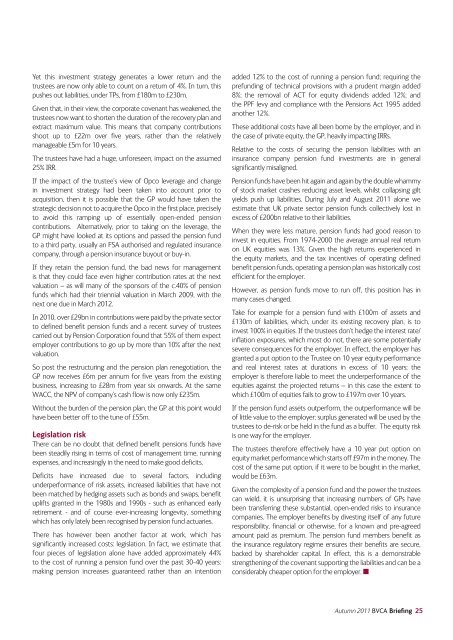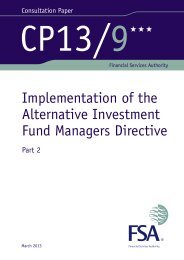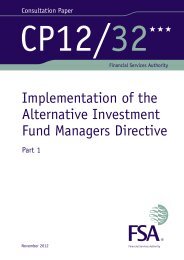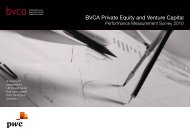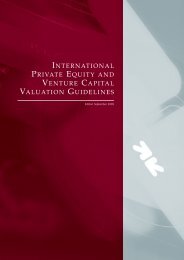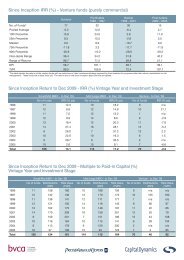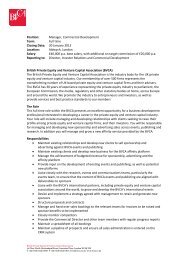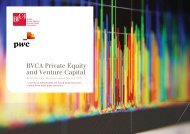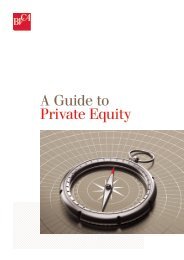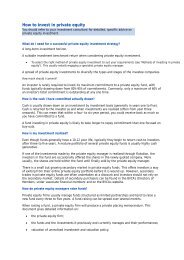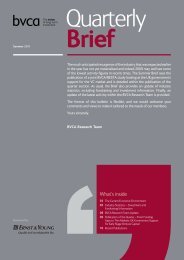You also want an ePaper? Increase the reach of your titles
YUMPU automatically turns print PDFs into web optimized ePapers that Google loves.
Yet this investment strategy generates a lower return and the<br />
trustees are now only able to count on a return of 4%. In turn, this<br />
pushes out liabilities, under TPs, from £180m to £230m.<br />
Given that, in their view, the corporate covenant has weakened, the<br />
trustees now want to shorten the duration of the recovery plan and<br />
extract maximum value. This means that company contributions<br />
shoot up to £22m over five years, rather than the relatively<br />
manageable £5m for 10 years.<br />
The trustees have had a huge, unforeseen, impact on the assumed<br />
25% IRR.<br />
If the impact of the trustee’s view of Opco leverage and change<br />
in investment strategy had been taken into account prior to<br />
acquisition, then it is possible that the GP would have taken the<br />
strategic decision not to acquire the Opco in the first place, precisely<br />
to avoid this ramping up of essentially open-ended pension<br />
contributions. Alternatively, prior to taking on the leverage, the<br />
GP might have looked at its options and passed the pension fund<br />
to a third party, usually an FSA authorised and regulated insurance<br />
company, through a pension insurance buyout or buy-in.<br />
If they retain the pension fund, the bad news for management<br />
is that they could face even higher contribution rates at the next<br />
valuation – as will many of the sponsors of the c.40% of pension<br />
funds which had their triennial valuation in March 2009, with the<br />
next one due in March 2012.<br />
In 2010, over £29bn in contributions were paid by the private sector<br />
to defined benefit pension funds and a recent survey of trustees<br />
carried out by Pension Corporation found that 55% of them expect<br />
employer contributions to go up by more than 10% after the next<br />
valuation.<br />
So post the restructuring and the pension plan renegotiation, the<br />
GP now receives £6m per annum for five years from the existing<br />
business, increasing to £28m from year six onwards. At the same<br />
WACC, the NPV of company’s cash flow is now only £235m.<br />
Without the burden of the pension plan, the GP at this point would<br />
have been better off to the tune of £55m.<br />
Legislation risk<br />
There can be no doubt that defined benefit pensions funds have<br />
been steadily rising in terms of cost of management time, running<br />
expenses, and increasingly in the need to make good deficits.<br />
Deficits have increased due to several factors, including<br />
underperformance of risk assets, increased liabilities that have not<br />
been matched by hedging assets such as bonds and swaps, benefit<br />
uplifts granted in the 1980s and 1990s - such as enhanced early<br />
retirement - and of course ever-increasing longevity, something<br />
which has only lately been recognised by pension fund actuaries.<br />
There has however been another factor at work, which has<br />
significantly increased costs: legislation. In fact, we estimate that<br />
four pieces of legislation alone have added approximately 44%<br />
to the cost of running a pension fund over the past 30-40 years:<br />
making pension increases guaranteed rather than an intention<br />
added 12% to the cost of running a pension fund; requiring the<br />
prefunding of technical provisions with a prudent margin added<br />
8%; the removal of ACT for equity dividends added 12%; and<br />
the PPF levy and compliance with the Pensions Act 1995 added<br />
another 12%.<br />
These additional costs have all been borne by the employer, and in<br />
the case of private equity, the GP, heavily impacting IRRs.<br />
Relative to the costs of securing the pension liabilities with an<br />
insurance company pension fund investments are in general<br />
significantly misaligned.<br />
Pension funds have been hit again and again by the double whammy<br />
of stock market crashes reducing asset levels, whilst collapsing gilt<br />
yields push up liabilities. During July and August 2011 alone we<br />
estimate that UK private sector pension funds collectively lost in<br />
excess of £200bn relative to their liabilities.<br />
When they were less mature, pension funds had good reason to<br />
invest in equities. From 1974-2000 the average annual real return<br />
on UK equities was 13%. Given the high returns experienced in<br />
the equity markets, and the tax incentives of operating defined<br />
benefit pension funds, operating a pension plan was historically cost<br />
efficient for the employer.<br />
However, as pension funds move to run off, this position has in<br />
many cases changed.<br />
Take for example for a pension fund with £100m of assets and<br />
£130m of liabilities, which, under its existing recovery plan, is to<br />
invest 100% in equities. If the trustees don’t hedge the interest rate/<br />
inflation exposures, which most do not, there are some potentially<br />
severe consequences for the employer. In effect, the employer has<br />
granted a put option to the Trustee on 10 year equity performance<br />
and real interest rates at durations in excess of 10 years; the<br />
employer is therefore liable to meet the underperformance of the<br />
equities against the projected returns – in this case the extent to<br />
which £100m of equities fails to grow to £197m over 10 years.<br />
If the pension fund assets outperform, the outperformance will be<br />
of little value to the employer; surplus generated will be used by the<br />
trustees to de-risk or be held in the fund as a buffer. The equity risk<br />
is one way for the employer.<br />
The trustees therefore effectively have a 10 year put option on<br />
equity market performance which starts off £97m in the money. The<br />
cost of the same put option, if it were to be bought in the market,<br />
would be £63m.<br />
Given the complexity of a pension fund and the power the trustees<br />
can wield, it is unsurprising that increasing numbers of GPs have<br />
been transferring these substantial, open-ended risks to insurance<br />
companies. The employer benefits by divesting itself of any future<br />
responsibility, financial or otherwise, for a known and pre-agreed<br />
amount paid as premium. The pension fund members benefit as<br />
the insurance regulatory regime ensures their benefits are secure,<br />
backed by shareholder capital. In effect, this is a demonstrable<br />
strengthening of the covenant supporting the liabilities and can be a<br />
considerably cheaper option for the employer. n<br />
Autumn 2011 <strong>BVCA</strong> <strong>Briefing</strong> 25


